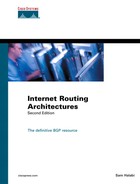Symmetry
Symmetry refers to when traffic leaving the AS from a given exit point comes back through the same point. This is easy to achieve if a single exit and entrance point exist. However, given the mandates of redundancy and the presence of multiple connections, traffic tends to be asymmetrical. When traffic is asymmetrical, customers and providers notice a lack of control over how traffic flows into and out of their ASs. Traffic leaving the AS from the East Coast might end up taking the "scenic route," coming back from the West Coast and traveling inside the AS multiple hops before returning to its origin. This is usually the result of closest-exit routing, as discussed in Chapter 6.
In reality, this is not as bad as it sounds. In some situations, asymmetrical traffic is acceptable, depending on the applications being used and the overall physical topology as far as the speed of the links and the number of hops between locations. In general, customers and providers would like to see their traffic come back close to or at the same point it left the AS to minimize potential delays that could be incurred otherwise. Then again, customers might want to carry the traffic as far as possible on their network to avoid latency or congestion on the peer network.
To accommodate symmetry, you should designate a primary link and make the utmost effort to direct the majority of traffic to flow on this link. Although I will discuss several methods of attaining symmetry via policy specification, it's important to understand that in practice, asymmetry is observed more often than not, and it usually doesn't pose significant problems.
